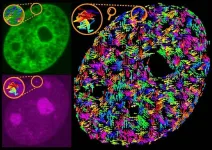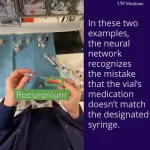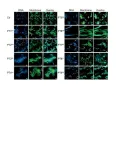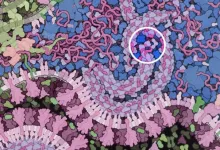(Press-News.org) A team of scientists has discovered surprising connections among gene activity, genome packing, and genome-wide motions, revealing aspects of the genome’s organization that directly affect gene regulation and expression.
The findings, reported in the journal Nature Communications, bolster our understanding of the mechanics behind transcription-dependent motions of single genes—the dysfunction of which may lead to neurological and cardiovascular disorders as well as to cancer.
“The genome is ‘stirred’ by transcription-driven motions of single genes,” explains Alexandra Zidovska, a professor of physics at New York University and the senior author of the study. “Genes move differently, depending on whether they are being read or not, leading to complex, turbulent-like motions of the human genome. Understanding the mechanics behind transcription-dependent motions of single genes in the nucleus might be critical for understanding the human genome in health and disease.”
The human genome consists of two meters (six and a half feet) of DNA, which is packed inside the cell in a nucleus barely 10 micrometers in diameter—or 100,000 times smaller than the length of the genome’s DNA. The DNA molecule encodes information for all cellular processes and functions, with genes serving as units of information. Different genes are read, and their information is processed at different times. When a gene is being read, there is molecular machinery that accesses it and transcribes its information into an mRNA molecule, a process known as transcription.
It had previously been discovered, by Zidovska and her colleagues, that the genome undergoes a lot of “stirring,” or movement, leading to its reorganization and repositioning in the nucleus.
However, the origin of these motions is little understood. Scientists have hypothesized that molecular motors fueled by adenosine triphosphate (ATP) molecules, which provide energy for many biological processes, are the drivers. These active motors are thought to apply forces on DNA, which can lead to a motion of DNA and the nucleoplasm—its surrounding fluid. But the larger physical machinations behind it remain elusive.
With this in mind, Zidovska and her colleagues focused on RNA polymerase II—responsible for the transcription and one of the most abundant molecular motors in the cell nucleus. When a gene is active, i.e. actively transcribed, the responsible molecular machinery applies forces on DNA during its processing.
The Nature Communications study investigated how a motion of a single actively transcribed gene affects the motions of the genome around it in live human cells. To do so, the authors employed CRISPR technology to fluorescently label single genes, two-color high-resolution live cell microscopy to visualize motion of these labeled genes, and displacement correlation spectroscopy (DCS) to simultaneously map flows of the genome across the nucleus. The high-resolution imaging data were then processed through a physical and mathematical analysis, uncovering a never-before-seen physical picture of how genes move inside the cell.
In their study, the researchers initially examined the motions of the genes—when they are inactive—then “switched” these genes on and observed how their motion changes once “active.” At the same time, the authors used DCS to map flows of the surrounding genome, monitoring how the genome flows across the nucleus before and after gene activation.
Overall, the authors found that active genes contribute to the stirring motion of the genome. Through simultaneous mapping of single-gene and genome-wide motions, they reveal that the compaction of the genome affects how the gene is contributing. Specifically, a motion-correlation analysis indicated that a single active gene drives the genome’s motions in low-compaction regions, but a high-compaction genome drives gene motion regardless of its activity state.
“By revealing these unexpected connections among gene activity, genome compaction, and genome-wide motions, these findings uncover aspects of the genome’s spatiotemporal organization that directly impact gene regulation and expression,” says Zidovska.
The work also adds to our understanding of physics.
“This research provides new insights into the physics of active and living systems,” she observes. “By revealing an emergent behavior of active living systems, such as the human genome, it teaches us new physics.”
The paper’s other authors were Fang-Yi Chu and Alexis S. Clavijo, NYU doctoral students, and Suho Lee, an NYU postdoctoral researcher.
This research was supported by grants from the National Institutes of Health (R00-GM104152 and R01-GM145924), the National Science Foundation (CAREER PHY-1554880, PHY-2210541, and CMMI-1762506), and a New York University Whitehead Fellowship for Junior Faculty in Biomedical and Biological Sciences.
Video:
This video depicts single gene motion within the surrounding genomic flows (Caption: motion of a single gene (white dot) is marked by its trajectory (colored curve) within the flows of the surrounding genome (arrows). Credit: Image courtesy of Alexandra Zidovska, Department of Physics, NYU).
# # #
END
Stirred, not shaken — Scientists uncover how transcription drives motion within the genome
Discovery sheds living daylight on the intricacies of gene transcription
2024-10-22
ELSE PRESS RELEASES FROM THIS DATE:
Engineering creates molecules that target cancer-causing proteins
2024-10-22
For some proteins, a single mutation, or change in its DNA instructions, is all it takes to tip the balance between functioning normally and causing cancer. But despite causing major disease, these slightly mutated proteins can resemble their normal versions so closely that treatments designed to target mutants could also harm healthy cells.
Led by researchers at NYU Langone Health and its Perlmutter Cancer Center, a new study describes the development of a biologic, a drug derived from natural biological systems, that targets a mutant cancer protein called HER2 (human epidermal growth factor receptor 2) without attacking ...
Wearable cameras allow AI to detect medication errors
2024-10-22
A team of researchers says it has developed the first wearable camera system that, with the help of artificial intelligence, detects potential errors in medication delivery.
In a test whose results were published today, the video system recognized and identified, with high proficiency, which medications were being drawn in busy clinical settings. The AI achieved 99.6% sensitivity and 98.8% specificity at detecting vial-swap errors.
The findings are reported Oct. 22 in npj Digital Medicine.
The system could ...
New bacterial toxins discovered: A key to fighting infections
2024-10-22
Researchers have discovered a new group of bacterial toxins that can kill harmful bacteria and fungi, opening the door to potential new treatments for infections. These toxins, found in over 100,000 microbial genomes, can destroy the cells of bacteria and fungi without harming other organisms. The study revealed how some bacteria use these toxins to compete with other microbes, and the findings could lead to new ways to fight infections, especially as antibiotic resistance becomes a growing concern.
A new ...
AI eye to eye with ophthalmologists in diagnosing corneal infections, study finds
2024-10-22
Eye care specialists could see artificial intelligence help in diagnosing infectious keratitis (IK), a leading cause of corneal blindness worldwide, as a new study finds that deep learning models showed similar levels of accuracy in identifying infection.
In a meta-analysis study published in eClinicalMedicine, Dr Darren Ting from the University of Birmingham conducted a review with a global team of researchers analysing 35 studies that utilised Deep Learning (DL) models to diagnose infectious keratitis.
AI models ...
Virginia Tech researcher works to preserve the white shark in the Mediterranean Sea
2024-10-22
The Mediterranean Sea is a paradise.
Pristine waters and an incredible coastline spanning multiple continents that are renowned the world over.
Below those picturesque, and sometimes crowded, waters swim a legendary creature facing a treacherous and uncertain future: the white shark.
Francesco Ferretti, an assistant professor in the College of Natural Resources and Environment, is working to save one of the most endangered white shark populations on the planet. The research team located signs of the remaining white sharks ...
How the coronavirus defeats the innate immune response
2024-10-22
The novel coronavirus SARS-CoV-2 has an enzyme that can counteract a cell’s innate defense mechanism against viruses, explaining why it is more infectious than the previous SARS and MERS-causing viruses. The Kobe University discovery may point the way to the development of more effective drugs against this and possibly similar, future diseases.
When a virus attacks, the body’s immune response has two basic layers of defense: the innate and the adaptive immune systems. While the adaptive immune system grows stronger against a specific pathogen as the body ...
APA Poll: Future of nation, economy and presidential election top U.S. stressors
2024-10-22
WASHINGTON — More than 7 in 10 adults said the future of the nation (77%) is a significant source of stress in their lives, with the economy (73%) and the 2024 U.S. presidential election (69%) following closely behind, according to the latest Stress in America™ survey released today by the American Psychological Association.
At the same time, the poll found many common stressors among people with different political party affiliations. The survey was conducted by The Harris Poll on behalf of APA among more ...
Towards better solar cells: Exploring an anomalous phenomenon of electricity generation
2024-10-22
The bulk photovoltaic (BPV) effect is an uncommon phenomenon that may enable certain materials to outperform the conventional p–n junctions used in solar cells. In a recent study, researchers from Japan have experimentally demonstrated the BPV effect in alpha-phase indium selenide (α-In2Se3) for the first time along the out-of-plane direction, validating previous theoretical predictions. The remarkable conversion efficiency recorded in their α-In2Se3 device signals a promising advancement for future solar cell technologies and photosensors.
A firm understanding ...
KERI’s innovation in anode materials for solid-state batteries selected as a cover article
2024-10-22
The KERI's research on anode materials for solid-state batteries (SSBs), conducted in collaboration with Kumoh National Institute of Technology and Inha University, has been selected as the cover article of a world-leading journal in the energy field.
The SSBs have replaced the combustible liquid electrolyte that transfers ions between the anode and cathode with a solid electrolyte, significantly reducing the risk of fire or explosion. However, SSBs, due to their 'solid' nature, require much advanced technology, such as ensuring electro-chemo-mechanical stability during the charging and discharging processes. In particular, since the anode has a ...
A visit from the stork brings genomic hope for this endangered species
2024-10-22
A Visit from the Stork Brings Genomic Hope for this Endangered Species
A new genomic study of the endangered Oriental Stork reveals that the population's genetic health is still surprisingly strong, with high genetic diversity and low levels of inbreeding. This is an uncommon finding in most endangered species populations, which makes it more difficult to rescue those species from extinction. Thus, despite the human-caused decline in the Oriental stork numbers, the findings in this study provide hope for the species' long-term ...
LAST 30 PRESS RELEASES:
Mount Sinai Health system receives $8.5 million NIH grant renewal to advance research on long-term outcomes in children with congenital heart disease
Researchers develop treatment for advanced prostate cancer that could eliminate severe side effects
Keck Medicine of USC names Christian Pass chief financial officer
Inflatable fabric robotic arm picks apples
MD Anderson and SOPHiA GENETICS announce strategic collaboration to accelerate AI-driven precision oncology
Oil residues can travel over 5,000 miles on ocean debris, study finds
Korea University researchers discover that cholesterol-lowering drug can overcome chemotherapy resistance in triple-negative breast cancer
Ushikuvirus: A newly discovered giant virus may offer clues to the origin of life
Boosting the cell’s own cleanup
Movement matters: Light activity led to better survival in diabetes, heart, kidney disease
Method developed to identify best treatment combinations for glioblastoma based on unique cellular targets
Self-guided behavioral app helps children with epilepsy sleep earlier
Higher consumption of food preservatives is associated with an increased risk of type 2 diabetes
NTU Singapore-led team captures first-ever ‘twitch’ of the eye’s night-vision cells as they detect light, paving the way for earlier detection of blindness-causing diseases
Global aviation emissions could be halved through maximising efficiency gains, new study shows
Fewer layovers, better-connected airports, more firm growth
Exposure to natural light improves metabolic health
As we age, immune cells protect the spinal cord
New expert guidance urges caution before surgery for patients with treatment-resistant constipation
Solar hydrogen can now be produced efficiently without the scarce metal platinum
Sleeping in on weekends may help boost teens’ mental health
Study: Teens use cellphones for an hour a day at school
After more than two years of war, Palestinian children are hungry, denied education and “like the living dead”
The untold story of life with Prader-Willi syndrome - according to the siblings who live it
How the parasite that ‘gave up sex’ found more hosts – and why its victory won’t last
When is it time to jump? The boiling frog problem of AI use in physics education
Twitter data reveals partisan divide in understanding why pollen season's getting worse
AI is quick but risky for updating old software
Revolutionizing biosecurity: new multi-omics framework to transform invasive species management
From ancient herb to modern medicine: new review unveils the multi-targeted healing potential of Borago officinalis
[Press-News.org] Stirred, not shaken — Scientists uncover how transcription drives motion within the genomeDiscovery sheds living daylight on the intricacies of gene transcription










